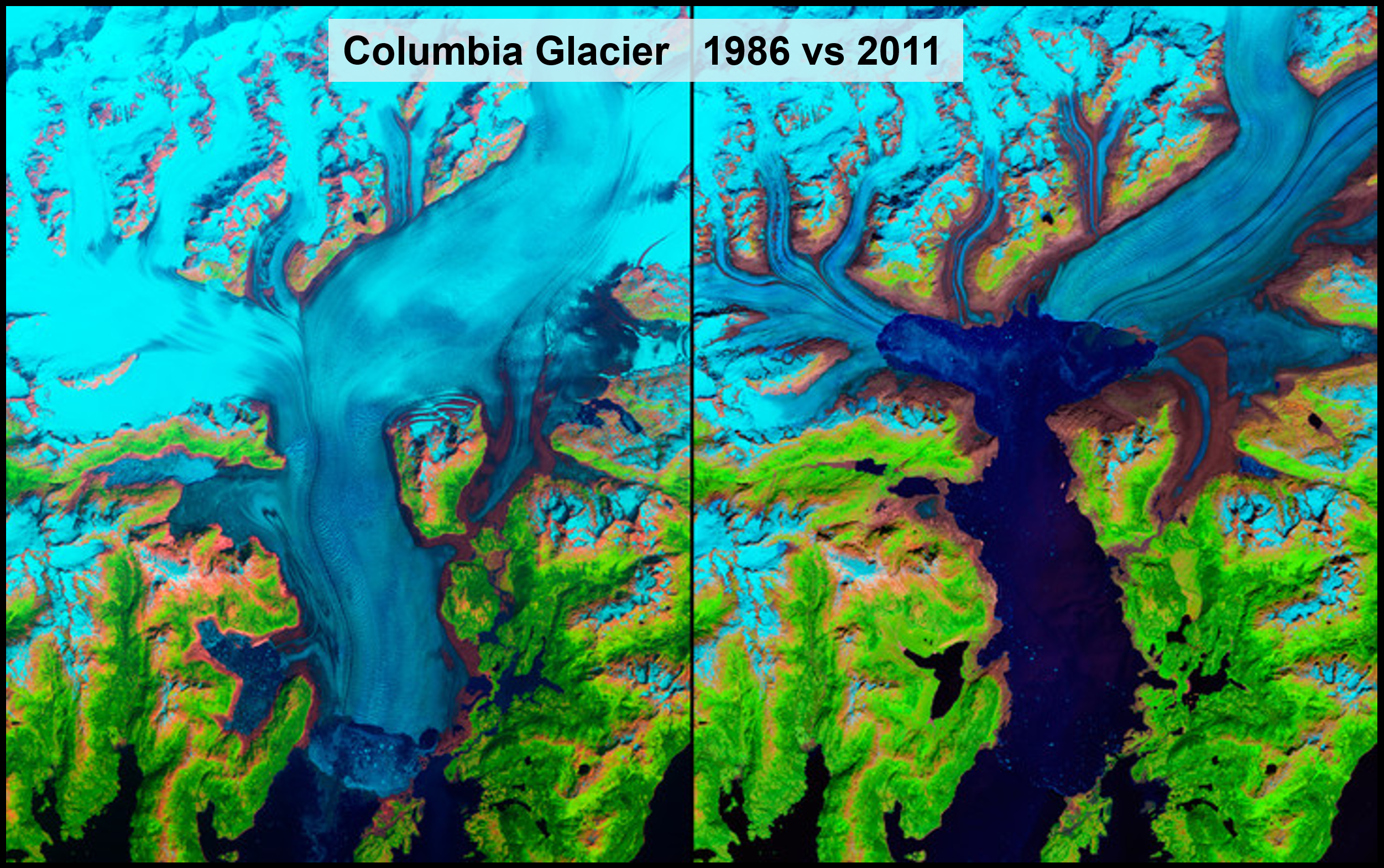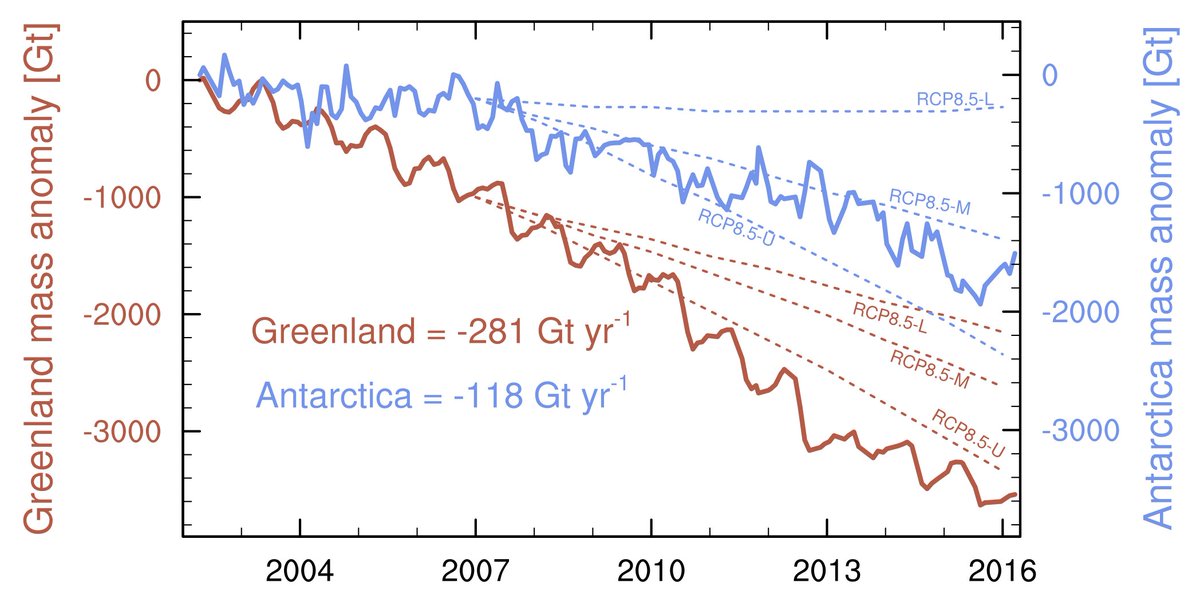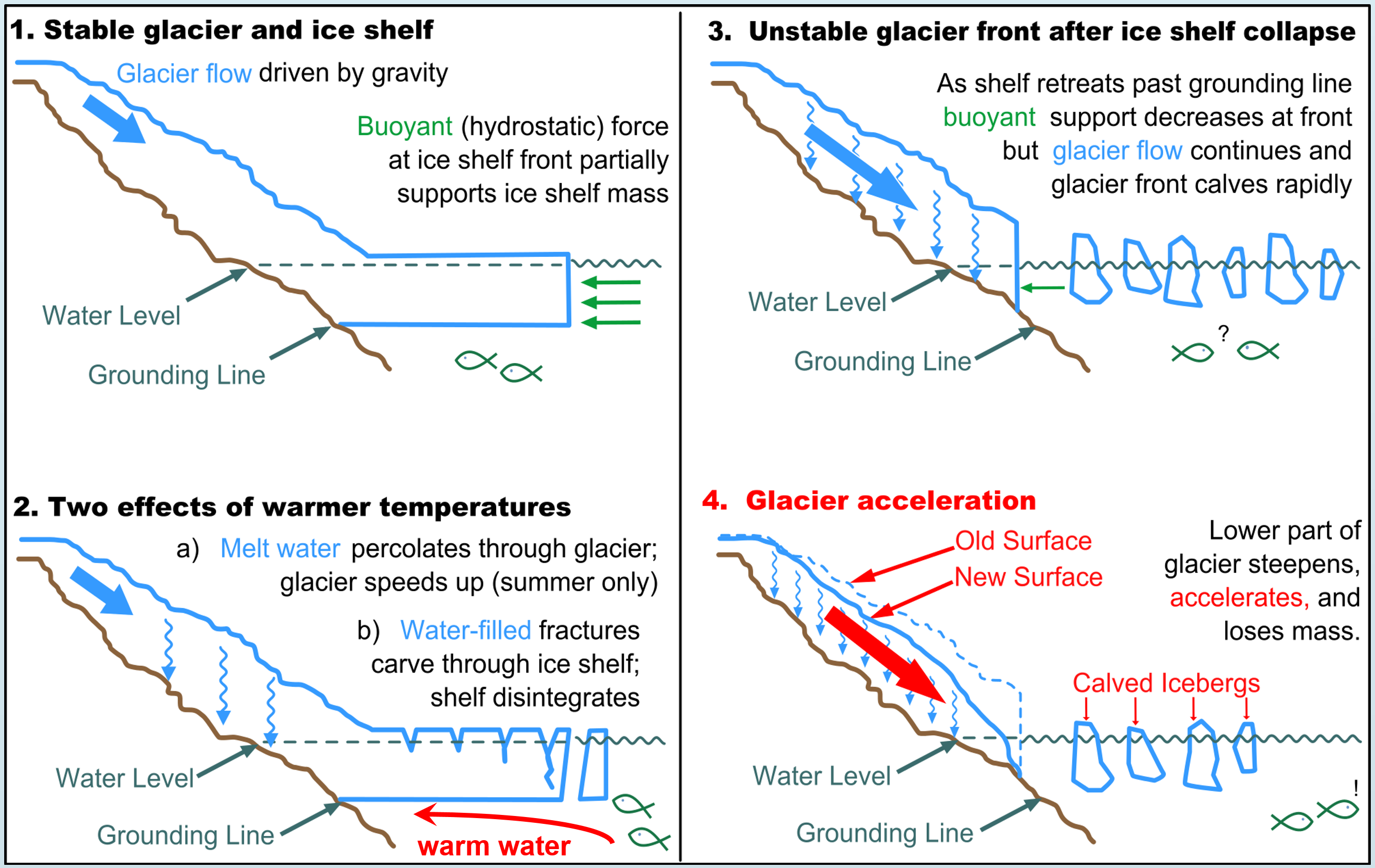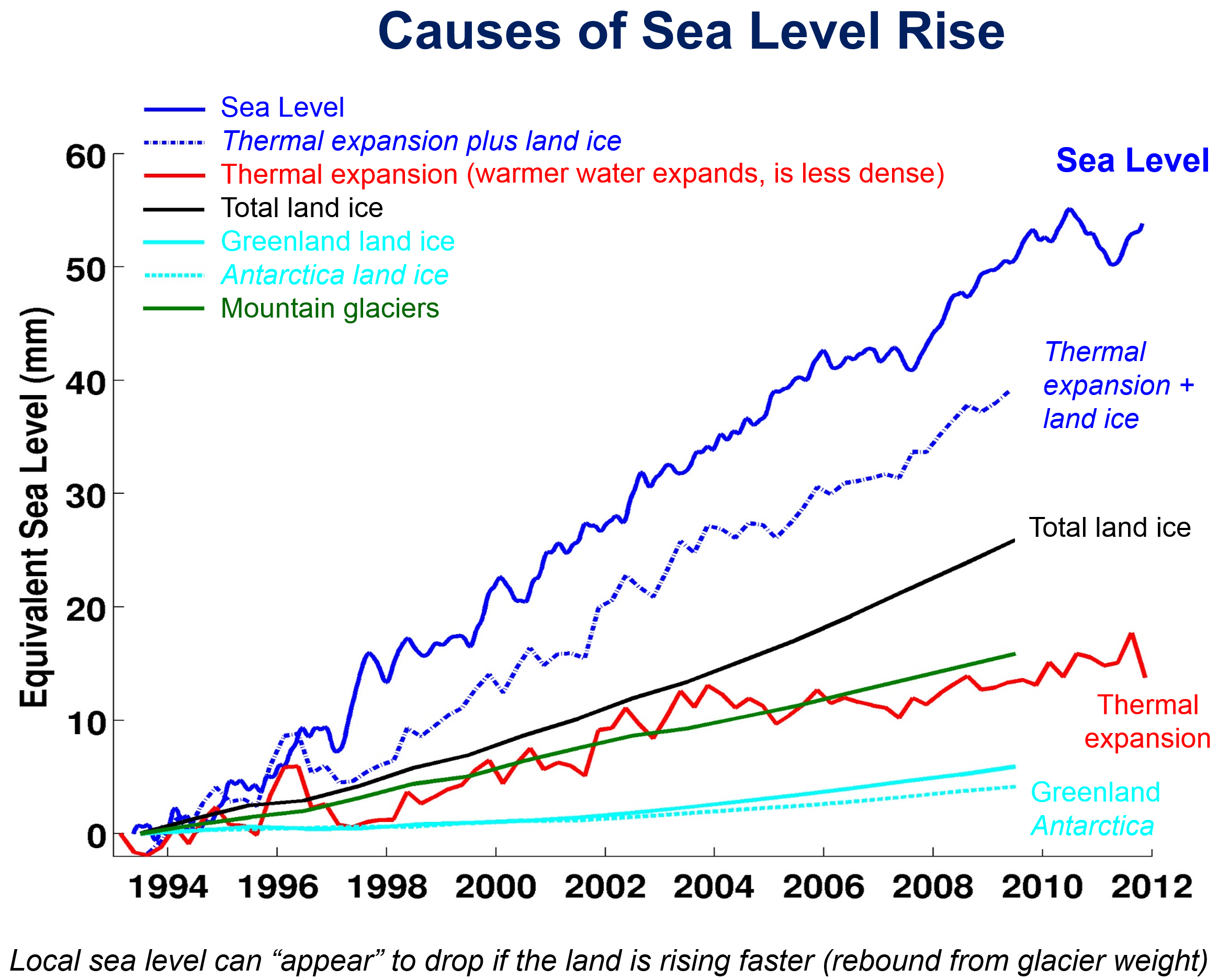We will learn: 1. What is dangerous climate change? 2. What causes sea level rise? 3. What is “Arctic Amplification” of climate change, and how is it affecting our weather today?
Jump to: [Introduction] [Dangerous Climate Change] [Sea Level Rise] [Arctic Amplification] [Summary] [Review] IntroductionIn this lecture we talk about how the Earth climate system is being affected by global warming, and we'll concentrate on the topics of sea level rise, arctic amplification of global warming, and "dangerous climate change". The concept of “dangerous climate change” lacks formal definition, but implies a warming threshold that if exceeded will cause major stress on human systems. Rising sea level has several causes, mainly thermal expansion from increasing ocean temperatures, and the melting of glaciers and ice sheets. Finally, Arctic soils (permafrost) are thawing, and the greenhouse gases released may amplify global climate warming. Dangerous Climate ChangeWe know fairly well what the direct effects of climate change are and will be. There is warming, and now more and more frequently we are experiencing extreme weather events – heat waves, drought, floods, hurricanes. Warming has also started to melt ice on oceans and on land, including mountain glaciers and giant ice sheets in Greenland and Antarctica. This melting has also contributed to sea level rise, and the warming and increasing carbon dioxide concentrations in the atmosphere are causing ocean acidification and the bleaching of coral reefs. In addition, there is a cascade of indirect effects of climate change on Earth's environment and its ecological and human-social systems. These ripple effects include impacts on ecosystems and adverse effects on ecosystem services (e.g., water, food, fiber), the reduction and potential shut-down of thermohaline circulation (see the Blue Planet lecture), adverse economic effects for most sectors, as well as adverse social and cultural effects (e.g., losing a sense of place as we discussed in the Great Lakes lecture). Probably the most striking impact of climate change in recent years has been the increased frequency and severity of storms, which is due to the intensification of the water cycle by increasing temperatures (Fig. 1). The scientific basis of this intensification was described in a previous lecture, and here we see that either temperature alone or water plus temperature influences have caused excessive heat waves, coastal flooding, extreme rain or snow events and severe droughts. There is limited evidence that climate change has directly led to more and larger hurricanes and cyclones over time. However, we have the scientific expectation that as temperatures rise and the water cycle intensifies, we will have stronger major storms.
Each year new records for climate extremes are set around the world, and it is easy to find these maps for recent years. Each year these extreme events become more common, and often the impacts become more severe. We can estimate the climate impacts on ecosystems and social systems by evaluating three factors. First is the Sensitivity, which is the degree to which a system is affected, either adversely or beneficially. Second is the Adaptive capacity, which is the ability of a system to adapt to climate change to moderate potential damage. Third is the Vulnerability, which is the degree to which geophysical, biological and socioeconomic systems are susceptible to, and unable to cope with, adverse impacts of climate change. An example of a system that has high sensitivity, high vulnerability, and low adaptive capacity is the island nation of the Maldives, which is at most about 2 meters above sea level. Unless we lower the greenhouse gases we put into the atmosphere, sea level rise may cause the Maldives to disappear by the end of this century. Sea Level Rise - climate warming and ice meltingOne of the most obvious consequences of global warming, or any warming, is that colder things become warmer and frozen things thaw or melt. And the sea ice in the Arctic, half of which has melted in less than a generation, is a sledge-hammer poster child for global warming. In addition, the ice loss and retreat of glaciers due to climate warming (there is no other possible cause) over at least the last 100 years is both striking and alarming. The melting and retreat has been closely documented in hundreds of glaciers (e.g., Fig. 2), and it has occurred in thousands of glaciers worldwide from the peak of Mt. Kilimanjaro in Africa to the continental U.S. with the loss of ice that gave Glacier National Park in Montana its name. The fact that as ice warms it melts needs no scientific explanation, and it is within the realm of a "duh" personal experience for nearly everyone worldwide. Thus, anyone who can read and write that denies climate warming's impact on glaciers or sea ice is either being deceived by others and doesn't care, or is deceiving others with a (hidden) agenda for personal power or wealth or both, as we discussed in the Critical Thinking lecture at the start of class this semester.
In addition to the montane and alpine glaciers melting around the world contributing to sea-level rise, the Earth's two major ice caps, Antarctica and Greenland, are also melting as shown in Figure 3. There are two important points to notice about this Figure. First, it appears that the rate of ice loss is increasing over time (the downward slopes of the curves are becoming more steep). Second, the dashed lines show the ice loss predicted by different models, starting in 2007 and using the RCP 8.5 (8.5 Watts per meter squared, or "business as usual) of warming into the future. Note that especially for Greenland, the actual ice loss has been greater than what was predicted. This underprediction of temperature or ice loss is actually a common feature of our climate models, and it is caused by two things: (1) scientists are inherently conservative and they tend to use conservative values in models, and (2) because the world's climate is changing at such a fast rate (faster than at any other time in at least the last 1 million years) the response of Earth's systems is surprising us and we are learning new ways in which the world works all the time. For example, the underprediction of Greenland ice loss was done by models that in 2007 did not include new modes of loss observed in 2010 and 2012 (hot years in Greenland) and only recently understood by scientists in 2017, such as the large wave that moved rapidly through the ice sheet due to partial melting at the ice base (link here). Overall, this means that our predictions of ice loss and sea level rise into the future may be underestimates. It is important at this point to distinguish between ice that is floating on the ocean, such as the Arctic sea ice mentioned above or the ice shelves that are extensions out into the ocean of land-based ice sheets, and the ice that is currently grounded on land. Melting ice that is grounded on land makes sea level rise. But because sea ice and ice shelves are already floating on the water, their melting does not contribute to sea-level rise. Consider putting an ice cube in a glass of water and then filling it to the brim. As the ice melts, will the glass overflow? No, because the weight of the ice is already accounted for in the level of water in the glass. And so it is with sea ice and ice shelves. However, the loss of ice shelves does contribute to speeding up the rate at which land-based ice sheets (the glaciers above them on land) are lost, in the following way (Fig. 4). In essence, ice shelves buttress ice sheets, slowing their flow toward the sea, but as ice shelves warm and become unstable, they calve into the sea faster and that reduces the "backpressure" and allows the ice sheets to flow faster. This acceleration of glaciers is especially fast in the West Antarctic ice sheet, where for example some glaciers have retreated up to 35 km in just 15 years. Such rapid changes provide support for predictions that this ice sheet will disintegrate much faster than originally thought, and in turn increase sea level faster than predicted.
At the moment the melting of ice sheets and smaller glaciers both contribute to sea level rise, although the huge ice sheets of Greenland and Antarctic have much greater potential to increase sea level (~6 m if Greenland melted, and ~60 m if Antarctica melted). But the other important cause of sea level rise today is the warming of the ocean. Recall from the Blue Planet lecture that as water warms it becomes less dense, or in other words it expands so that fewer molecules occupy the same volume (that is the definition of density, the mass per volume). This thermal expansion of water in the ocean has caused almost half of the sea-level rise we have experienced so far, the rest being due mainly to melting ice (Fig. 5). A final topic in this discussion of dangerous climate and it's impacts is the possibility that while the Arctic is certainly a victim of global warming, it may also be a culprit in the future. The reason is that almost two-thirds of all the carbon in soils on Earth is stored in frozen soils (permafrost) in the high northern latitudes. This is twice the amount of carbon currently in our atmosphere, and as these permafrost soils melt they could contribute even more carbon in the form of greenhouse gases, causing an amplification of global climate warming. The amplification works like this. Once the soil carbon is unfrozen it can be attacked by soil microbes, and as you learned microbes convert organic carbon into inorganic carbon in respiration, which produces CO2 that can enter the atmosphere. As shown in Figure 6, as the permafrost thaws there will be more CO2 released, which will increase the heat-trapping effect in our atmosphere and acclerate global warming, which will in turn thaw the permafrost soils faster. This is the definition of a "positive feedback loop", and at present this Arctic Amplification is not considered in any of our global climate models predicting Earth's temperature in the future. Figure 6. The "artic amplification" of climate change involves a positive feedback where increased warming thaws more permafrost soils, which release more greenhouse gases, which increases global warming. This "positive feedback loop" associated with amplification is similar to the feedback between a guitar and amplifier, something for which the 1960s icon Jimi Hendrix was famous (below). One might be tempted to argue that this permafrost thawing will be slow and only affect us in the future, but, it turns out that past and current warming in the Arctic is already having an affect on our short-term weather. This effect on weather is manifest through a weakening of the "jet stream", the westerly winds that move across northern mid-latitudes that are featured in most weather forecasts on TV or online. Because the Arctic has been warming faster than the rest of the world, the difference in air pressure between lower latitudes and higher latitudes has been decreasing, causing a weaker jet stream. We don't yet fully understand what controls jet streams, but recent studies are showing that weaker jet streams tend to get "stuck" in one place, leading to longer dry spells or longer rainy periods. This effect has contributed to the well-documented increase in the frequency and intensity of rainstorms in recent years, and is consistent with the idea of a warmer world intensifying the water cycle and leading to stronger storms. Summary
The TAKE-HOME MESSAGE of this lecture is: "The more we know about climate change, the more scared we should be..."
|



 .
.
